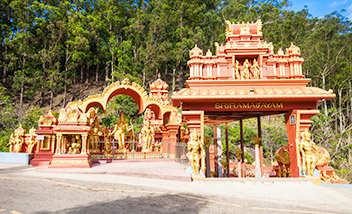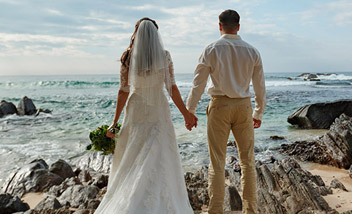

Q. What are the popular beaches in Sri Lanka?
A. All Sri Lanka packages would include stays at the island-nation's beach getaways. You need to select the ones you prefer after doing your own research. Close to its capital Colombo is the quaint fishing village of Negombo, now a plush seaside resort. It has a stunning stretch of coastline, palm groves crowding them and the beaches clean and well-maintained. It is a great idea to stay at a beach resort and enjoy the setting of its atmospheric private beach. Bentota is another popular beach getaway in Sri Lanka visited predominantly for its water sports scene. The beach is otherwise a silken stretch of sand lying on the west coast, with the sands running south from the Bentota lagoon, a few atmospheric hotels speckled on its fringes. The waters of the Bentota Beach are ideal for jet-skiing, with kayaking opportunities abounding on the lagoon. You can even take a boat ride among the mangrove wilderness. Bentota lies mid-way between Colombo and Galle. Head to the Arugam Bay on the east coast made famous by wave surfers. The area is still quaint and have a few guesthouses dotting the coast. For some off-beat beach getaways, visit Hiriketiya on the south coast, a horseshoe- shaped stretch of unspoilt sand that is slowly climbing up the popularity charts.
Q. What is Galle in Sri Lanka famous for?
A. Most Sri Lanka tour packages would have Galle in the itinerary. Here is why. A UNESCO World Heritage Site, Galle is an old-world historical town that is best explored on foot. An erstwhile trading port, Galle's clutch of Dutch-colonial structures, age-old churches, mosques, museums and elaborate mansions, several in disuse, is the reason tourists regularly find their way to this Sri Lankan gem. Soak up the atmosphere as you saunter down its narrow lanes lined with cosy cafes, quaint boutiques, souvenir shops and a handful heritage hotels and, not to mention, an interesting milieu of people comprising artists, painters, writers, musicians, designers, photographers and amusing locals. It was the Dutch that built this port city in the 17 th century, especially its most iconic structure, the Galle Fort, which is at the heart of Galle, an imposing walled enclave surrounded by the sea on three sides. Stay at a quaint heritage property in Galle and take in its special aura and all its maritime history related at several of its museums and places of sightsee. Saying nothing of its stunning seaside setting.
Q. Is Sri Lanka hot round the year?
A. Prior to booking one of the Sri Lanka holiday packages, you need to first decide on the season in which you plan to visit and whether it would be conducive to your travels. The island-nation has a diverse topography made of tropical forests, beaches, rich ethnic heritage and an eclectic biodiversity. Sri Lanka has both dry and wet seasons. May to November are the monsoon months affecting predominantly Sri Lanka's south western part. But come December and the dry spell begins lasting till April. But monsoon comes to Sri Lanka in phases. The north eastern monsoon, for instance, brings thunder and rains to the northern and eastern coastal region from October to January, the dry spell beginning from May and going on till September. For the lover of sunshine, the December to April window is ideal. A dry period with ample sun in the day and a pleasant breeze coming in from the sea at nights, this is the best time to visit its churches, archaeological ruins, tea gardens and hill stations. Avoid travelling to Sri Lanka from May to August as it remains very hot and muggy during the day, hampering your travels.
Q. Which is the best time to visit Sri Lanka?
A. If you are planning to book one of the Sri Lanka packages, you must first consider the best time to visit the island nation. Tropical jungles, sparkling beaches, azure waters, rich history, a vibrant culture, spirituality and biodiversity symbolise Sri Lanka, and owing to its diverse topography it remains a top destination on the list of holidaymakers. The country experiences distinct dry and wet seasons. The south western monsoon brings rain to Sri Lanka's south western region between May and November and keeping it dry between December and April. The north eastern monsoon on the other hand brings rain to the eastern and northern coastal regions between October and January, keeping it dry between May and September. For a culture connoisseur and sunshine lover, the December to April window is the best to visit Sri Lanka as this is generally the dry period and a great time to visit its historical ruins, elaborate temples, old-world churches and its hill stations. The shoulder season, however, remains between September and November. But you need to avoid Sri Lanka between May and August because of the heat and humidity making it impossible to travel around.
Q. What is the local language of Sri Lanka?
A. Before you shortlist one of the Sri Lanka holiday packages, you must know of its local language and whether or not you would be comfortable travelling around the country. Sinhala, the native language of the Sinhalese people is most widely spoken while the other fraction speaks Tamil. English serves as a link language and most cabbies, hotels and places of entertainment speak and understand English. So you can do with English in most part of the country, especially touristy places like Bentota, Colombo, Negombo, Kandy among others. But if you are travelling rurally, it might not be the case, as the folks would converse only in their local language. But on the whole you can get around in Sri Lanka with just English.
Q. Is there any time difference between India and Sri Lanka?
A. When looking up Sri Lanka tour packages, its best to know the time difference between both the countries. But there is no time difference between India and Sri Lanka.
Q. What is the currency of Sri Lanka and can I get it changed locally in Sri Lanka?
A. As you finalise one of the Sri Lanka travel packages, you should be apprised of the local currency of Sri Lanka and the current conversion rate. Sri Lankan Rupee is the currency of Sri Lanka with 1 India National Rupee (INR) equalling 2.70 Sri Lankan Rupees (LKR). The Indian Rupees is not officially accepted in Sri Lanka and you can't even exchange it with any official exchanger, so it is best to not arrive in Sri Lanka with just INR. You are better off by converting INR into USD in India, and not from the airport, but from your bank. Then change the USD to LKR at one of the banks outside Colombo airport at live rate. Plenty hotels in Sri Lanka accept USD as modes of payment, and most international cards too work in Sri Lanka.
Q. Which Indian cities have direct flights to Sri Lanka?
A. You can fly directly to Colombo from New Delhi, Mumbai, Bangalore and Chennai. The Sri Lankan Airlines having direct operations between the countries.
Q. Which are Sri Lanka's most prominent beach destinations?
A. Hiriketiya on the south coast is gaining popularity among tourists though it is aloof and offers a peaceful ambience. The coast here is dotted with several unspoilt beaches with the most stunning one being the horseshoe-shaped bay called Hiriketiya, which also has some wonderful places to stay in its vicinity. Bentota is another fine stretch of sand on the west coast, with the beach running south from the pristine Bentota lagoon and backed by a string of charming hotels. The Bentota beach is also Sri Lanka's water activity hub, for instance you can pursue jet-skiing and kayaking in the calm waters of the lagoon, while the others can do boat rides through the mangrove jungles. This lies halfway between Galle and Colombo. Arugam Bay on the east coast originally put on the map by surfers is a palm-fringed stretch of beach with several quaint guesthouses in its vicinity. Mirissa and Uppuveli are other sleepy beach villages known for their golden sands.
Q. What is Galle in Sri Lanka famous for?
A. Galle is a historic city, a UNESCO World Heritage Site that is lovely to be explored on foot. It is a truly old-world trading port studded with looming Dutch-colonial buildings, old churches and mosques, rambling mansions and museums. As you stroll down its endless lanes, you will find chic cafes, pretty boutiques and some heritage hotels and lots of interesting folk from photographers, artists, designers, writers to quirky locals. This port city was originally built by the Dutch peoples in 1663, particularly the Fort area which forms Galle's core which is a walled enclave with the ocean surrounding it on three sides. Galle's ambience is its biggest draw, and an unmissable destination on your trip to Sri Lanka.
Q. Which is Sri Lanka's most popular hill station?
A. Sri Lanka has several hill stations known for their nippy climes and rambling jungles ideal for nature walks and bird watching. Nuwara Eliya is Sri Lanka's most famous hill station famed for its undulating tea estates. The region is studded with waterfalls, gardens, tea plantations, lakes, making Nuwara Eliya as scenic as it gets. Add to its ambience, the colonial-era buildings, misty golf courses and the lovely, frosty climate. Small wonder it is also known as Little England. Among other hill stations you can round up on your trip to Sri Lanka comprise Kandy, Ella stands out for its iconic nine arches railway bridge, a colonial-era construction, and Kitulgala nestled in a pristine forested area.
Q. What is the cuisine of Sri Lanka like?
A. Sri Lankan cuisine is well known for achieving a fine blend of spices, herbs, vegetables, rice, fruits and fish. Normally, the diet is rice-centric with coconut available through the year forming a staple ingredient in most recipes. Seafood plays a major role in the cuisine of Sri Lanka, the sea ensuring a fresh supply of crabs, prawns, squids, and King Fish round the year. Fish is used in all forms whether fresh or preserved and the recipes are inspired by various cultural influences that Sri Lanka has drawn over the years from ethnic groups, colonists, through local traditions among others. Majorly, Sri Lankan cuisine is inspired by South Indian cuisine, Dutch cuisine, Indonesian cuisine aside from its other Asian and southeast Asian neighbours. A typical Sri Lankan dish of rice and prawn curry is a must on your visit to the island country. Add a plate of hoppers or appam to your breakfast, or if you are a little too adventurous the Kiribath, rice cooked in salted coconut milk and served with a relish made from chillies and red onion. This dish is specially had on birthdays and New Year's.
Q. How to get a tourist visa to Sri Lanka?
A. Getting a tourist visa to Sri Lanka for an Indian is considerably easy. An Indian passport holder can obtain visa on arrival free of cost or they can apply for an Electronic Travel Authorisation or ETA and you are granted a stay for up to 30 days in a go. The ETA though remains valid for 180 days after issued from the date of application and lets you gain double entry into the country. All you need to submit personal details and email address. The ETA is generally processed within 2 working days and the processing charges are free.

Colombo - Chilaw - Trincomalee - Lakegala - Dunuwila - Kandy - Nuwara Eliya- Kat..

Negombo - Bentota - Nuwara Eliya - Kandy - Peradeniya - Colombo
.jpg)
Negombo - Dambulla - Anuradhapura - Habarana - Kandy - Ella - Yala - Colombo